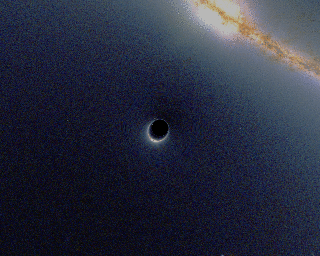 |
| English: Shows slices of expansion of universe without an initial singularity (Photo credit: Wikipedia) |
 |
| An example of simulated data modelled for the CMS particle detector on the Large Hadron Collider (LHC) at CERN. Here, following a collision of two protons, a is produced which decays into two jets of hadrons and two electrons. The lines represent the possible paths of particles produced by the proton-proton collision in the detector while the energy these particles deposit is shown in blue. (Photo credit: Wikipedia) |
Read on...
-----
BY DENNIS OVERBYE
CAMBRIDGE, Massachusetts – When scientists jubilantly announced last month that a telescope at the South Pole had detected ripples in space from the very beginning of time, the reverberations went far beyond the potential validation of astronomer’s most cherished model of the Big Bang.
It was the second time in less than two years that ideas thought to be radical just decades ago had been confirmed (so the optimists think) by experiment.
The first was the discovery of the Higgs boson, associated with an energy field that gives mass to other particles, announced in July 2012.
Now the South Pole telescope team, led by John M. Kovac of the Harvard-Smithsonian Center for Astrophysics, has presented physicists with another clue from what the Russian cosmologist Yakov B. Zeldovich once called the poor man’s particle accelerator – the universe itself.
The ripples detected by the telescope, Bicep2, were faint spiral patterns from the polarization of microwave radiation left over from the Big Bang.
These gravitational waves are the long-sought markers for a theory called inflation, the force that put the bang in the Big Bang: an antigravitational swelling that began a trillionth of a trillionth of a trillionth of a second after the cosmic clock started ticking. Scientists have long incorporated inflation into their standard model of the cosmos, but proving it had long been elusive.
Astronomers say they expect to be studying the gravitational waves from mountaintops, balloons and perhaps satellites for the next 20 years, hoping to gain insight into mysteries like dark matter and dark energy.
The question before astronomers and physicists now is understanding what caused inflation. What is this stuff that “turns gravity on its head” – as Alan Guth of Massachusetts Institute of Technology, a founder of inflation theory, has put it – and blew up the universe?
Einstein introduced the notion of antigravity into physics. For him it was known as the cosmological constant, a factor he used to account for the fact that the universe didn’t collapse.
He later abandoned the cosmological constant, calling it a mistake, but it was resurrected 15 years ago when astronomers discovered that the expansion of the universe was speeding up because of the mysterious force called dark energy. As with inflation, the repulsion is part of space itself: The bigger the universe gets, the more powerfully it pushes apart, resulting in an exponential runaway expansion.
Assuming they are confirmed, the Bicep2 results would eliminate most versions of inflation that have been proposed, including the Higgs, according to Andrei Linde, a physicist at Stanford University in California.
Knowing inflation’s identity could be crucial if scientists are to unwind cosmic history to the beginning, when they suspect the universe was ruled by a single unified force instead of the four we know today: gravity, electromagnetism and the strong and weak nuclear forces.
The Bicep2 waves seem to date from the time that theorists suspect electromagnetism and the weak force divorced the strong force, gravity having already gone its own way, but Dr.Linde says that could be a coincidence.
If the chain of evidence and reasoning holds up, however, the Bicep2 waves do bear witness to the most fervently hoped-for unification of all, or what John A. Wheeler of Princeton University in New Jersey once called “the fiery marriage “ of Einstein’s gravity, which shapes the universe, and quantum theory, which governs the behavior of atoms inside it.
According to inflation theory, the Bicep2 waves are magnified images of the hypothetical particles called gravitons that would transmit gravity in quantum theory. The gravitons, theory says, are produced by the same process by which black holes leak. It is known as Hawking radiation, after Stephen Hawking of Cambridge University, the renowned black hole theorist, who discovered it in 1973.
If the Bicep2 results are confirmed, and if astronomers agree that the ripples were gravitational waves from inflation, the discovery of Hawking radiation could win a Nobel Prize for Dr. Hawking.
Hawking radiation has been part of the physics firmament for decades; it’s the best-known prediction of quantum gravity.
Max Tegmark, a cosmologist at Massachusetts Institute of Technology, noted that some physicists had wondered whether gravity obeyed the dice-playing quantum principles that Einstein had disdained.
He said, “Now we know that gravity is indeed quantized, involving graviton particles.”
Taken from TODAY Saturday Edition, April 5, 2014

























































